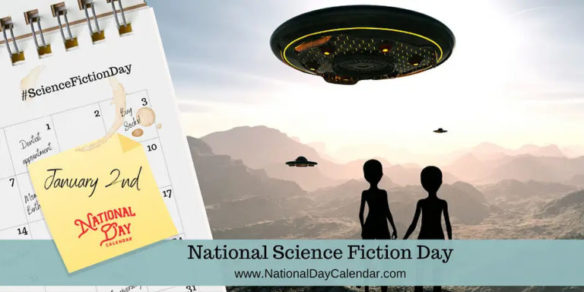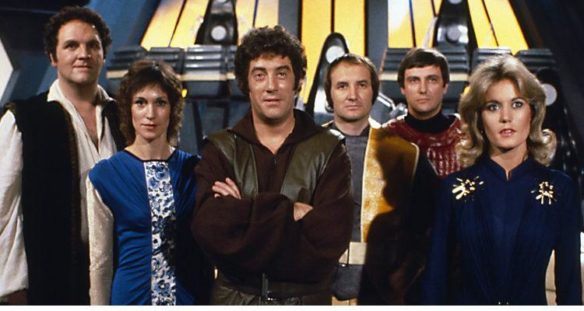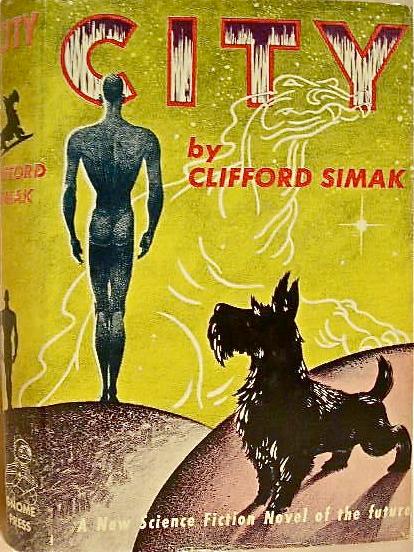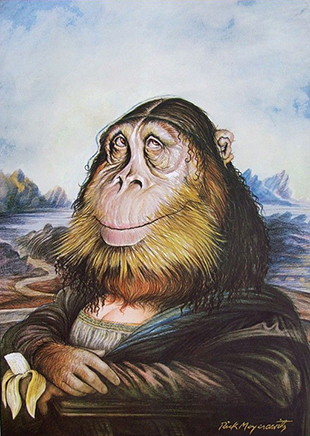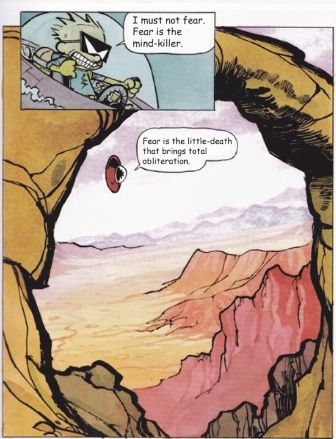(1) HOW THE BESTSELLER LIST IS WON. Several authors responded to Sarah Pinborough’s question about whether certain kinds of sales affect the UK bestseller lists.
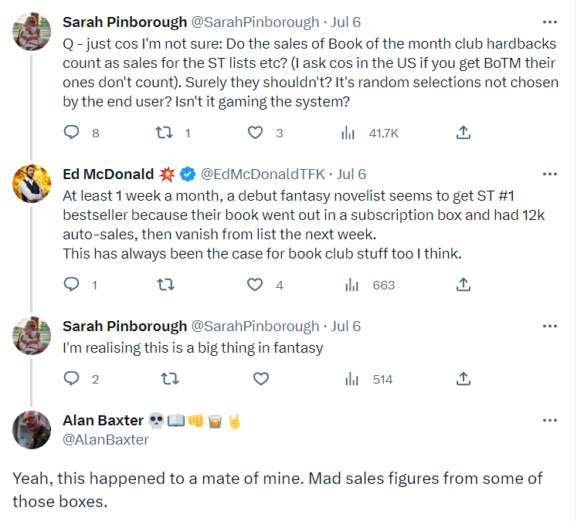



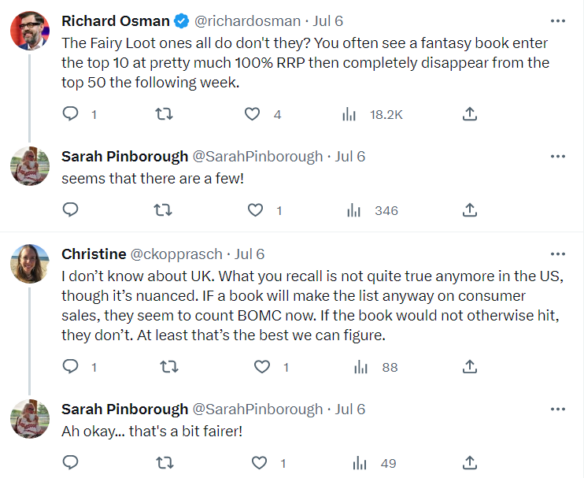
(2) THE FUTURE IS NOW. “’It’s not climate change, it’s everything change’: sci-fi authors take on the global crisis” in the Guardian.
… a new generation of writers now believes it is impossible to write “near future” sci-fi without putting the climate emergency at the forefront of their speculative fiction. For many, this is because they are living through the crisis and can imagine all too easily what may happen if real-life behaviour doesn’t change….
… [EJ Swift says] “Climate breakdown is escalating so rapidly that events which 10 years ago might have seemed like the distant future are happening now. Everything is filtered through that lens – even when it’s not the main focus, climate anxiety is there in the periphery.”
Other recent books dealing with the devastation to the climate include Kate Sawyer’s The Stranding, which begins with the striking image of two strangers sheltering in the mouth of a dead, beached whale as a calamitous extinction event hits the world, Susannah Wise’s This Fragile Earth, in which the complete failure of all technology brings into focus our uneasy relationship with nature, and Sarah K Jackson’s Not Alone, about a mother and son surviving in the aftermath of a microplastics storm that has decimated the population.
The science fiction writer Adrian Tchaikovsky, known for his huge, widescreen space opera novels set in distant galaxies, is turning his attention to the climate crisis next year with a horror novella called Saturation Point….
(3) PARSING THE 2023 HUGO BALLOT. John Scalzi shares insights “about why the Hugos are the way they are these days: Why Tor seems to get a lot of nominations, for example, and why diverse groups are represented in the finalist list as they are, and whether the Hugo voters are an insular and monolith bloc” in “Hugo Neepery, Via Reddit” at Whatever.
… If you are wondering how marginalized groups have started to become widely represented in SF/F awards (as they are not just in the Hugos, but also the Nebulas, the Locus and the World Fantasy Awards) there are three factors I want you to consider. The first is the (relative) decline of the “Big Three” short fiction magazines in SF/F (Asimov’s, Analog, F&SF) and the commensurate rise of a series of online short fiction publishing venues like Uncanny, Clarkesworld and Strange Horizons (among others). The Big Three ran on Silent, Boomer and Elder GenX writers, and the market forces for the genre those writers came up in was heavily cis and white and male. The newer venues, by inclination and necessity, cultivated younger generations of writers from more diverse backgrounds. When the Big Three declined and the online magazines rose, their respective stables of authors more or less rose or declined with them, in terms of award consideration.
The second thing to consider is who is buying science fiction and fantasy, both in the magazine and in the publishing houses. Surprise! The editorial stratum of SF/F/H is not the straight, white and (predominately but not exclusively) male enclave it was before; the editorial bench of SF/F/H publishing (and publishing generally) is much more queer and of color than it has been in years past. They are interested in publishing more than just the “usual suspects” in SF/F/H as defined by previous decades and — this is important — the diverse SF/F/H they are acquiring is selling very well. This will naturally have an impact on what is considered at awards time.
The third thing to consider with respect to the Hugos specifically is that close to a decade ago a group of right-wing fans and writers, alarmed by what they saw as left-wing, SJW, politically-correct, etc work creeping into the awards, decided to try to run slates of work to counter that trend. This did not go well, in no small part because their tactics energized a very large group of fandom to counter their actions, including a significant number of more progressive Hugo voters. When the “takeover” of the Hugos failed, most of these right-wing folks flounced from the Hugo voting pool; some of the more progressive voters stayed and continue to vote today. This is reflected in what gets nominated and thus, what eventually becomes a finalist….
(4) CAN YOU BLAME HIS PARENTS? “Calvin and Hobbes’ Creator Already Answered Fans’ Darkest Question” claims MSN.com. The comic’s creator Bill Watterson gave an unexpectedly deep answer to an interviewer.
…WEST: The parents are really an interesting part of the strip. In a way they’re foils, but the thing that interests me is that it’s extremely rare for them to express any love for Calvin. Is that simply because it doesn’t have any comic potential, or is it something inherent in their characters?
WATTERSON: Again, I feel like I’m falling into the trap of psychoanalyzing the characters and I don’t want to say, “Well, this character acts this way,” because that’s confining. I think the way they relate to Calvin is more a reflection of my misanthropic tendencies than any literary concern.
Many strips have, you know, the funny character, the straight man, the foil — those characters are stereotypes and fairly flat. The role of these characters in the strip is entirely defined by their function as a member of a social group or age group, or whatever, and I’m trying to avoid that as much as I possibly can. I try to make each character, even the ones that aren’t that important, a unique personality that, over time, will develop. Some of the minor characters appear less often than Calvin and Hobbes, but, hopefully, over years, each one will become a unique personality that will be every bit as complex and interesting as Calvin and Hobbes.
In other words, I don’t want the parents to simply function as parents. I want them to be unique individuals as well. They are parents, of course, and, as sane people, they have to react to Calvin’s personality. What I try to do in writing any character is to put myself in his position, to the extent that I can, and I know that if I was Calvin’s dad or Calvin’s mom that I would not react to him with the gooey sentimentality that sometimes appears in other strips. Given Calvin’s usual behavior, I think his parents show admirable restraint in theirs….
(5) IT MIGHT HAPPEN. “Neil Gaiman Adapting Samuel R. Delany’s Nova as a Series” reports CBR.com.
…The report comes from a New Yorker profile on the 81-year-old Delany, which mentioned that Gaiman was adapting Nova for a Prime Video series. Gaiman was briefly interviewed for the article, and called Delany a profound influence whose work inspired him to attempt a similar sophisticated tone in his comics such as The Sandman. “I was used to very functional prose,” Gaiman said, calling the author by his nickname Chip. “Chip felt like I’d taken a step into poetry… There was no limit to how good you could be in your chosen area.” Prime Video has not yet confirmed a Nova series at this time….
(6) SUPERMAN. Animation World Network reports “‘My Adventures with Superman’ Episode 1 Now on YouTube”.
Adult Swim has released the first full episode of My Adventures with Superman on YouTube – or you can watch it below. The series, which features Jack Quaid as Clark Kent, Alice Lee as Lois Lane, and Ishmel Sahid as Jimmy Olsen, is Warner Bros. Animation and DC’s newest animated series. The first two episodes are now streaming on Max. One new episode will debut every Thursday at midnight on Adult Swim and the next day on Max. It is unknown if future episodes will hit YouTube as well.
A serialized coming-of-age story, My Adventures with Superman follows 20-somethings Clark Kent, the bright and driven Lois Lane, and their best friend Jimmy Olsen as they begin to discover who they are and everything they can accomplish together as an investigative reporting team at the Daily Planet….
(7) MEMORY LANE.
2010 – [Written by Cat Eldridge from a choice by Mike Glyer.]
South Africa is one of those countries just starting to get known for its genre fiction. Though it goes back a century in terms of a history of science fiction being created there, that fiction like the greater culture there has been irretrievably changed by Apartheid and the novel Mike has chosen this time is one of those works.
Lauren Beukes is our author this time, she’s written six novels including the forthcoming Bridges, some of which are SF, some of which are mysteries.
Great mysteries too though the cringe factor is really high in them. Blood and gore everywhere. Now the SF she has written is first rate — imaginative storytelling that is noticeably different has it is, well, rooted in South African history and culture. One most of us aren’t familiar with.
Zoo City was published in trade paper thirteen years ago by Umuzi / Random House Struik. The cover art is by Joey Hi- Fi. It would win both a Clarke Award and a Kitschie, and be nominated for a BSFA, Otherwise, and a World Fantasy Award.
And now for our Beginning…
In Zoo City, it’s impolite to ask.
Morning light the sulfur color of the mine dumps seeps across Johannesburg’s skyline and sears through my window. My own personal bat signal. Or a reminder that I really need to get curtains.
Shielding my eyes—morning has broken and there’s no picking up the pieces—I yank back the sheet and peel out of bed. Benoît doesn’t so much as stir, with only his calloused feet sticking out from under the duvet like knots of driftwood. Feet like that, they tell a story. They say he walked all the way from Kinshasa with his Mongoose strapped to his chest.
The Mongoose in question is curled up like a furry comma on my laptop, the glow of the LED throbbing under his nose. Like he doesn’t know that my computer is out of bounds. Let’s just say I’m precious about my work. Let’s just say it’s not entirely legal.
I take hold of the laptop on either side and gently tilt it over the edge of my desk. At thirty degrees, the Mongoose starts sliding down the front of the laptop. He wakes with a start, tiki tavi claws scrabbling for purchase. As he starts to fall, he contorts in the air and manages to land feet first. Hunching his stripy shoulders, he hisses at me, teeth bared. I hiss back. The Mongoose realizes he has urgent flea bites to attend to.
Leaving the Mongoose to scrolf at its flank, I duck under one of the loops of rope hanging from the ceiling, the closest I can get to providing authentic Amazon jungle vines, and pad over the rotten linoleum to the cupboard. Calling it a cupboard is a tad optimistic, like calling this dank room with its precariously canted floor and intermittent plumbing an apartment is optimistic. The cupboard is not much more than an open box with a piece of fabric pinned across it to keep the dust off my clothes—and Sloth, of course. As I pull back the gaudy sunflower print, Sloth blinks up at me sleepily from his roost, like a misshapen fur coat between the wire hangers. He’s not good at mornings.

(8) TODAY’S BIRTHDAYS.
[Compiled by Cat Eldridge.]
- Born July 9, 1906 — Walter Sande. He’s best remembered for being on Red Planet Mars, The War of the Worlds and Invaders from Mars, but he also showed up playing a heavy in such serials as The Green Hornet Strikes Again! and Sky Raiders, the latter being at least genre adjacent. He’s had a recurring role as Col. Crockett on The Wild Wild West, and one-offs on Voyage to the Bottom of The Sea, The Man from U.N.C.L.E., Lost in Space and Bewitched. (Died 1971.)
- Born July 9, 1911 — Mervyn Peake. Best remembered for the Gormenghast series which is quite delightfully weird. Most fans hold that there are but three novels in the series (Titus Groan, Gormenghast and Titus Alone) though there’s a novella, “Boy in Darkness”, that is a part of it. Peake planned a fourth book, Titus Awakes, but it was barely begun when he died. Maeve Gilmore, Peake’s widow, wrote the manuscript of a version titled Search Without End which remained unpublished until decades after her death. It incorporates a fragmentary text written by Peake. The Gormenghast series has been adapted for radio three times and television once, and it was announced in 2018 that Gaiman is writing the script for an adaptation. (Died 1968.)
- Born July 9, 1944 — Glen Cook, 79. Yes, I’ve read his entire excellent Black Company series. I’ve also mostly liked his far lighter Garrett P.I. series (though not the last novel for reasons I’ll not discuss here) which it seems unfortunately he’s abandoned. And I really should read the Instrumentalities of the Night as I’ve heard good things about it. I’m really, really surprised not only that he hasn’t won any awards, but how few he’s been nominated for.
- Born July 9, 1945 — Dean Koontz, 78. The genres of of mystery, horror, fantasy and science fiction are all home to him. Author of over a hundred novels, his first novel was SF — it being Star Quest (not in print) published as an Ace Double with Doom of the Green Planet by Emil Petaja. ISFDB claims over half of his output is genre, I’d say that a low estimate.
- Born July 9, 1954 — Ellen Klages, 69. Her story “Basement Magic” won a Nebula Award for Best Novelette. I strongly recommend Portable Childhoods, a collection of her short fiction, published by Tachyon Publications, my favorite publisher of fantasy. They released another collection from her, Wicked Wonders, which is equally wonderful. Passing Strange, her novel set in 1940s San Francisco, which won a BSFA Award and a World Fantasy Award, is also really great. Ok, I really like her.
- Born July 9, 1970 — Ekaterina Sedia, 53. Her Heart of Iron novel which was nominated for a Sidewise Award for Alternate History is simply awesome. I’d also recommend The Secret History of Moscow and the recent The House of Discarded Dreams as well, the latter is a fantastic audio work which is narrated by Robin Miles. It’s worth noting that the usual suspects list several collections by her, Willful Impropriety: 13 Tales of Society, Scandal, and Romance and Wilfill Impropriety that ISFDB doesn’t list. They’re quite superb it turns out as is Paper Cities: An Anthology of Urban Fantasy for which she won a World Fantasy Award. She had a story out just last year, “Ghost Shop”, in Professor Charlatan Bardot’s Travel Anthology to the Most (Fictional) Haunted Buildings in the Weird, Wild World. She’s amply stocked at the usual suspects. She’s also very deeply stocked at the audio suspects as well which sort of surprised and delighted me as I’ve added a number of her works to my To Be Listened to list, including The House of Discarded Dreams which sounds really fascinating in the manner of Gaiman’s Sandman.
(9) COMICS SECTION.
- JumpStart involves some surprisingly early memories of Isaac Asimov.
- Herman shows aliens getting their own first encounter.
- Six Chix has a cool librarian joke.
(10) BEWARE THE BLINDING LIGHT. [Item by Mike Kennedy.] No, not the blinding light of atomic explosions in the Oppenheimer biopic, but the blinding light of full nudity, at least one sex scene, and an on-again-off-again love triangle. All involving Oppenheimer himself.
One guesses this may be how the flick gained its R rating. Which doesn’t mean those things were inserted just for titillation, apparently they are true to his complicated story. “It Appears The R-Rated ‘Oppenheimer’ Will Be The Sauciest Movie The Decidedly Un-Saucy Christopher Nolan Has Ever Made” at Uproxx.
Christopher Nolan movies do love — sometimes. Memento and Inception feature dead wives who haunt their heroes. There’s a tragic love triangle in The Dark Knight and a tragic love quadrangle in The Prestige. That’s it! What he doesn’t do is sex and/or nudity. Oppenheimer, his forthcoming film about the “father of the atomic bomb,” is going to change that. If you thought the film’s R-rating — Nolan’s first since 2002’s Insomnia — was due to graphic A-bomb carnage…well, you may be right about that. But it’s also because there’s apparently a fair amount of kink….
(11) TAKE A WALK ON THE WILD SIDE. Tour the wild animal bridge inspired by the life of P-22, the fabled mountain lion of Griffith Park. NBC Los Angeles invites you to “Take a free tour of the Wallis Annenberg Wildlife Crossing”.
… This celebrated span, in short, will do an immeasurable amount of good for an incredible number of critters that both roam and home in the area.
That important education? It comes courtesy of the National Wildlife Federation’s #SaveLACougers campaign, which is shedding an informative light on the upcoming Wallis Annenberg Wildlife Crossing via several docent-helmed tours at the Agoura Hills site.
The under-construction skyway, or “wildway” if you prefer, will allow animals to move safely above the 101 freeway, significantly (and safely) expanding their frontiers.
And while the Wallis Annenberg Wildlife Crossing, which broke ground in the spring of 2022, still has a ways to go before the jubilant ribbon-cutting, supporters of urban wildlife can take a look at the progress now and find out more about the bridge’s development and progress….
(12) SHIFTING GEARS. This is a good time to revisit the question “What Is the Antikythera Mechanism, the World’s First Computer?” Smithsonian Magazine answers it in this 2015 article.
After 2,000 years under the sea, three flat, misshapen pieces of bronze at the National Archaeological Museum in Athens are all shades of green, from emerald to forest. From a distance, they look like rocks with patches of mold. Get closer, though, and the sight is stunning. Crammed inside, obscured by corrosion, are traces of technology that appear utterly modern: gears with neat triangular teeth (just like the inside of a clock) and a ring divided into degrees (like the protractor you used in school). Nothing else like this has ever been discovered from antiquity. Nothing as sophisticated, or even close, appears again for more than a thousand years.
For decades after divers retrieved these scraps from the Antikythera wreck from 1900 to 1901, scholars were unable to make sense of them. X-ray imaging in the 1970s and 1990s revealed that the device must have replicated the motions of the heavens. Holding it in your hands, you could track the paths of the Sun, Moon and planets with impressive accuracy. One investigator dubbed it “an ancient Greek computer.” But the X-ray images were difficult to interpret, so mainstream historians ignored the artifact even as it was championed by fringe writers such as Erich von Däniken, who claimed it came from an alien spaceship. It wasn’t until 2006 that the Antikythera mechanism captured broader attention. That year, Mike Edmunds of Cardiff University in Wales and his team published CT scans of the fragments, revealing more details of the inner workings, as well as hidden inscriptions—and triggering a burst of scholarly research….
(13) VIDEO OF THE DAY. “Smoking Causes Coughing” is French comedy with 50’s sf flair.
After a devastating battle against a diabolical turtle, a team of five avengers – known as the TOBACCO FORCE – is sent on a mandatory retreat to strengthen their decaying group cohesion. Their break goes wonderfully well until Lézardin, Emperor of Evil, decides to annihilate planet Earth… But will they repair their relationship in time for a final epic battle?
[Thanks to Michael Toman, Cat Eldridge, SF Concatenation’s Jonathan Cowie, Steven French, Ersatz Culture, Daniel Dern, Mike Kennedy, Andrew Porter, John King Tarpinian, and Chris Barkley for some of these stories. Title credit belongs to File 770 contributing editor of the day SocialInjusticeWorrier.]






